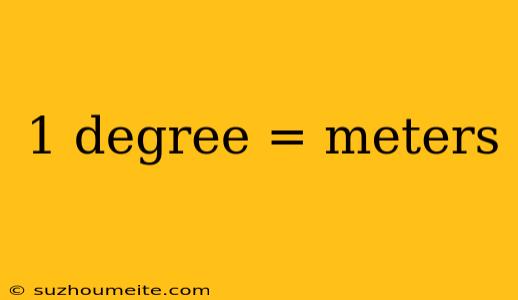1 Degree = Meters: Understanding Latitude and Longitude
Latitude and longitude are the coordinates used to locate a point on the Earth's surface. While we often use degrees to measure latitude and longitude, have you ever wondered how many meters are in one degree? In this article, we'll explore the conversion between degrees and meters and how it's used in navigation and mapping.
What is a Degree?
A degree is a unit of measurement used to express the size of an angle. In the context of latitude and longitude, a degree is equal to 1/360 of a circle. There are 360 degrees in a full circle, with 180 degrees being the equivalent of a straight line.
Converting Degrees to Meters
To convert degrees to meters, we need to know the radius of the Earth. The Earth's radius is approximately 6,371 kilometers. We can use this value to convert degrees to meters using the following formula:
1 degree = π x radius / 180
Where π is a constant approximately equal to 3.14.
Plugging in the value of the Earth's radius, we get:
1 degree ≈ 111,320 meters
This means that one degree of latitude or longitude is equivalent to approximately 111,320 meters.
Latitude vs. Longitude
While both latitude and longitude are measured in degrees, they are not equal in terms of distance. Latitude measures the distance north or south of the equator, while longitude measures the distance east or west of the prime meridian.
Latitude
- 1 degree of latitude is approximately equal to 111,320 meters
- The distance between two points of latitude remains constant, regardless of the longitude
Longitude
- 1 degree of longitude is approximately equal to 111,320 meters at the equator
- The distance between two points of longitude varies depending on the latitude, with the distance decreasing as you move towards the poles
Applications in Navigation and Mapping
Understanding the conversion between degrees and meters is crucial in navigation and mapping. Here are a few examples:
- GPS Navigation: GPS relies on accurate latitude and longitude coordinates to provide location information. By converting these coordinates to meters, GPS devices can provide precise distance and direction calculations.
- Map Projections: Map projections, like the Mercator projection, use the conversion between degrees and meters to create accurate representations of the Earth's surface on a 2D map.
- Surveying: Surveyors use the conversion between degrees and meters to calculate precise distances and angles between landmarks and reference points.
In conclusion, understanding that 1 degree is equal to approximately 111,320 meters is essential in navigation, mapping, and many other fields. By converting degrees to meters, we can make more accurate calculations and measurements, ultimately improving our ability to navigate and understand the world around us.
